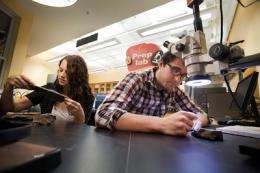Dinosaur detectives put themselves on display

Putting itself on display through a clear glass window, the Cornell-affiliated Museum of the Earth's fossil preparation laboratory has opened to visitors, who can now watch paleontologists -- including several Cornell students -- carve away at hunks of rock to reveal the fossils inside.
"It's a great opportunity to show visitors how you go from a fossil that you find in the earth in some desert somewhere to one ready for research or display," said Richard Kissel, director of teacher programs at the museum's parent organization, the Paleontological Research Institution (PRI), who teaches courses at Cornell. "The windows open, so our fossil experts that work in the lab can interact with the public."
The new laboratory facilities, which include a scanning electron microscope and other advanced technology, will benefit researchers as well as curious visitors.
"We haven't really had any space to do research," said Warren Allmon, PRI director and the Hunter Rawlings III Professor of Paleontology at Cornell, at the museum Sept. 21. "This is a huge step forward for us, to have our own scanning electron microscope, to have state-of-the-art lab spaces -- the kind of lab spaces a real museum should have."
Researchers who will use the lab include Cornell students, several of whom have worked in the PrepLab since the museum opened in 2003. Allmon brings his Paleobiology (Earth and Atmospheric Sciences 4790) class here to do laboratory work, and each student completes an independent research project using the museum's resources. For some students, like Drew Muscente '12, this project grows into a senior thesis.
"We aren't sure what it is," Muscente said of the feather-shaped fossil he is studying for his thesis. "It's been debated heavily whether it's plant or animal. I'm using different photography methods and the scanning electron microscope to look for new characteristics that would allude to what it was."
While other samples of Muscente's fossil can be found all over Ithaca, other fossils studied in the lab come from farther afield. Kissel showed reporters a large rock and explained how the paleontologists would work on it.
"We're going to slowly cut the burlap and plaster off, and then using our tools, chip away the rock to ultimately reveal the dinosaur bones inside," he said, adding that although researchers know where the rock comes from (Utah) and how old it is (some 150 million years), they aren't certain what's inside.
"This is pretty exciting," he said. "This will be one of the showcases for the lab opening."
In addition to PrepLab, the museum has recently renovated its BioLab, PaleoLab and WetLab, though PrepLab will be the only one displayed to the public. BioLab, which served as a kitchen when the building was an orphanage, has been converted to a "clean" room where researchers carry out microscope work and chemical procedures. PaleoLab, in contrast, is the "dirty" room, with a special sink to wash many specimens at once. And in WetLab, researchers work with live mollusks and invertebrates, studying predator and prey ecology.
"A prevalent misconception is that museum workers spend their days inspecting a rock that only vaguely resembles a dinosaur bone and mumbling incoherently to themselves in voices raspy from breathing paleolithic dust and toxic mold," said Dana Friend, a graduate student in the field of earth and atmospheric studies who works in the WetLab. "I do neither!"
Provided by Cornell University


















